Cover
Universitext
Title: Mathematical Analysis II
Copyright
Prefaces
Preface to the English Edition
Preface to the Fourth Russian Edition
Preface to the Third Russian Edition
Preface to the Second Russian Edition
Preface to the First Russian Edition
Table of Contents
9 *Continuous Mappings (General Theory)
9.1 Metric Spaces
9.1.1 Definition and Examples
9.1.2 Open and Closed Subsets of a Metric Space
9.1.3 Subspaces of a Metric space
9.1.4 The Direct Product of Metric Spaces
9.1.5 Problems and Exercises
9.2 Topological Spaces
9.2.1 Basic Definitions
9.2.2 Subspaces of a Topological Space
9.2.3 The Direct Product of Topological Spaces
9.2.4 Problems and Exercises
9.3 Compact Sets
9.3.1 Definition and General Properties of Compact Sets
9.3.2 Metric Compact Sets
9.3.3 Problems and Exercises
9.4 Connected Topological Spaces
9.4.1 Problems and Exercises
9.5 Complete Metric Spaces
9.5.1 Basic Definitions and Examples
9.5.2 The Completion of a Metric Space
9.5.3 Problems and Exercises
9.6 Continuous Mappings of Topological Spaces
9.6.1 The Limit of a Mapping
9.6.2 Continuous Mappings
9.6.3 Problems and Exercises
9.7 The Contraction Mapping Principle
9.7.1 Problems and Exercises
10 *Differential Calculus from a more General Point of View
10.1 Normed Vector Spaces
10.1.1 Some Examples of Vector Spaces in Analysis
10.1.2 Norms in Vector Spaces
10.1.3 Inner Products in Vector Spaces
10.1.4 Problems and Exercises
10.2 Linear and Multilinear Transformations
10.2.1 Definitions and Examples
10.2.2 The Norm of a Transformation
10.2.3 The Space of Continuous Transformations
10.2.4 Problems and Exercises
10.3 The Differential of a Mapping
10.3.1 Mappings Differentiable at a Point
10.3.2 The General Rules for Differentiation
10.3.3 Some Examples
10.3.4 The Partial Derivatives of a Mapping
10.3.5 Problems and Exercises
10.4 The Finite-increment Theorem and some Examples of its Use
10.4.1 The Finite-increment Theorem
10.4.2 Some Applications of the Finite-increment Theorem
10.4.3 Problems and Exercises
10.5 Higher-order Derivatives
10.5.1 Definition of the nth Differential
10.5.2 Derivative with Respect to a Vector and Computation of the Values of the nth Differential
10.5.3 Symmetry of the Higher-order Differentials
10.5.4 Some Remarks
10.5.5 Problems and Exercises
10.6 Taylor's Formula and the Study of Extrema
10.6.1 Taylor's Formula for Mappings
10.6.2 Methods of Studying Interior Extrema
10.6.3 Some Examples
10.6.4 Problems and Exercises
10.7 The General Implicit Function Theorem
10.7.1 Problems and Exercises
11 Multiple Integrals
11.1 The Riemann Integral over an n-Dimensional Interval
11.1.1 Definition of the Integral
11.1.2 The Lebesgue Criterion for Riemann Integrability
11.1.3 The Darboux Criterion
11.1.4 Problems and Exercises
11.2 The Integral over a Set
11.2.1 Admissible Sets
11.2.2 The Integral over a Set
11.2.3 The Measure (Volume) of an Admissible Set
11.2.4 Problems and Exercises
11.3 General Properties of the Integral
11.3.1 The Integral as a Linear Functional
11.3.2 Additivity of the Integral
11.3.3 Estimates for the Integral
11.3.4 Problems and Exercises
11.4 Reduction of a Multiple Integral to an Iterated Integral
11.4.1 Fubini's Theorem
11.4.2 Some Corollaries
11.4.3 Problems and Exercises
11.5 Change of Variable in a Multiple Integral
11.5.1 Statement of the Problem and Heuristic Derivation of the Change of Variable Formula
11.5.2 Measurable Sets and Smooth Mappings
11.5.3 The One-dimensional Case
11.5.4 The Case of an Elementary Diffeomorphism in IR^n
11.5.5 Composite Mappings and the Formula for Change of Variable
11.5.6 Additivity of the Integral and Completion of the Proof of the Formula for Change of Variable in an Integral
11.5.7 Corollaries and Generalizations of the Formula for Change of Variable in a Multiple Integral
11.5.8 Problems and Exercises
11.6 Improper Multiple Integrals
11.6.1 Basic Definitions
11.6.2 The Comparison Test for Convergence of an Improper Integral
11.6.3 Change of Variable in an Improper Integral
11.6.4 Problems and Exercises
12 Surfaces and Differential Forms in IR^n
12.1 Surfaces in IR^n
12.1.1 Problems and Exercises
12.2 Orientation of a Surface
12.2.1 Problems and Exercises
12.3 The Boundary of a Surface and its Orientation
12.3.1 Surfaces with Boundary
12.3.2 Making the Orientations of a Surface and its Boundary Consistent
12.3.3 Problems and Exercises
12.4 The Area of a Surface in Euclidean Space
12.4.1 Problems and Exercises
12.5 Elementary Facts about Differential Forms
12.5.1 Differential Forms: Definition and Examples
12.5.2 Coordinate Expression of a Differential Form
12.5.3 The Exterior Differential of a Form
12.5.4 Transformation of Vectors and Forms under Mappings
12.5.5 Forms on Surfaces
12.5.6 Problems and Exercises
13 Line and Surface Integrals
13.1 The Integral of a Differential Form
13.1.1 The Original Problems, Suggestive Considerations, Examples
13.1.2 Definition of the Integral of a Form over an Oriented Surface
13.1.3 Problems and Exercises
13.2 The Volume Element. Integrals of First and Second Kind
13.2.1 The Mass of a Lamina
13.2.2 The Area of a Surface as the Integral of a Form
13.2.3 The Volume Element
13.2.4 Expression of the Volume Element in Cartesian Coordinates
13.2.5 Integrals of First and Second Kind
13.2.6 Problems and Exercises
13.3 The Fundamental Integral Formulas of Analysis
13.3.1 Green's Theorem
13.3.2 The Gauss—Ostrogradskii Formula
13.3.3 Stokes' Formula in IR^3
13.3.4 The General Stokes Formula
13.3.5 Problems and Exercises
14 Elements of Vector Analysis and Field Theory
14.1 The Differential Operations of Vector Analysis
14.1.1 Scalar and Vector Fields
14.1.2 Vector Fields and Forms in IR^3
14.1.3 The Differential Operators grad, curl, div, and \nabla
14.1.4 Some Differential Formulas of Vector Analysis
14.1.5 *Vector Operations in Curvilinear Coordinates
14.1.6 Problems and Exercises
14.2 The Integral Formulas of Field Theory
14.2.1 The Classical Integral Formulas in Vector Notation
14.2.2 The Physical Interpretation of div, curl, and grad
14.2.3 Other Integral Formulas
14.2.4 Problems and Exercises
14.3 Potential Fields
14.3.1 The Potential of a Vector Field
14.3.2 Necessary Condition for Existence of a Potential
14.3.3 Criterion for a Field to be Potential
14.3.4 Topological Structure of a Domain and Potentials
14.3.5 Vector Potential. Exact and Closed Forms
14.3.6 Problems and Exercises
14.4 Examples of Applications
14.4.1 The Heat Equation
14.4.2 The Equation of Continuity
14.4.3 The Basic Equations of the Dynamics of Continuous Media
14.4.4 The Wave Equation
14.4.5 Problems and Exercises
15 integration of Differential Forms on Manifolds
15.1 A Brief Review of Linear Algebra
15.1.1 The Algebra of Forms
15.1.2 The Algebra of Skew-symmetric Forms
15.1.3 Linear Mappings of Vector Spaces and the Adjoint Mappings of the Conjugate Spaces
15.1.4 Problems and Exercises
15.2 Manifolds
15.2.1 Definition of a Manifold
15.2.2 Smooth Manifolds and Smooth Mappings
15.2.3 Orientation of a Manifold and its Boundary
15.2.4 Partitions of Unity and the Realization of Manifolds as Surfaces in IR^n
15.2.5 Problems and Exercises
15.3 Differential Forms and Integration on Manifolds
15.3.1 The Tangent Space to a Manifold at a Point
15.3.2 Differential Forms on a Manifold
15.3.3 The Exterior Derivative
15.3.4 The Integral of a Form over a Manifold
15.3.5 Stokes' Formula
15.3.6 Problems and Exercises
15.4 Closed and Exact Forms on Manifolds
15.4.1 Poincare's Theorem
15.4.2 Homology and Cohomology
15.4.3 Problems and Exercises
16 Uniform Convergence and the Basic Operations of Analysis on Series and Families of Functions
16.1 Pointwise and Uniform Convergence
16.1.1 Pointwise Convergence
16.1.2 Statement of the Fundamental Problems
16.1.3 Convergence and Uniform Convergence of a Family of Functions Depending on a Parameter
16.1.4 The Cauchy Criterion for Uniform Convergence
16.1.5 Problems and Exercises
16.2 Uniform Convergence of Series of Functions
16.2.1 Basic Definitions and a Test for Uniform Convergence of a Series
16.2.2 The Weierstrass Μ-test for Uniform Convergence of a Series
16.2.3 The Abel-Dirichlet Test
16.2.4 Problems and Exercises
16.3 Functional Properties of a Limit Function
16.3.1 Specifics of the Problem
16.3.2 Conditions for Two Limiting Passages to Commute
16.3.3 Continuity and Passage to the Limit
16.3.4 Integration and Passage to the Limit
16.3.5 Differentiation and Passage to the Limit
16.3.6 Problems and Exercises
16.4 *Compact and Dense Subsets of the Space of Continuous Functions
16.4.1 The Arzelà—Ascoli Theorem
16.4.2 The Metric Space C(K, Y)
16.4.3 Stone's Theorem
16.4.4 Problems and Exercises
17 Integrals Depending on a Parameter
17.1 Proper Integrals Depending on a Parameter
17.1.1 The Concept of an Integral Depending on a Parameter
17.1.2 Continuity of an Integral Depending on a Parameter
17.1.3 Differentiation of an Integral Depending on a Parameter
17.1.4 Integration of an Integral Depending on a Parameter
17.1.5 Problems and Exercises
17.2 Improper Integrals Depending on a Parameter
17.2.1 Uniform Convergence of an Improper Integral with Respect to a Parameter
17.2.2 Limiting Passage under the Sign of an Improper Integral and Continuity of an Improper Integral Depending on a Parameter
17.2.3 Differentiation of an Improper Integral with Respect to a Parameter
17.2.4 Integration of an Improper Integral with Respect to a Parameter
17.2.5 Problems and Exercises
17.3 The Eulerian Integrals
17.3.1 The Beta Function
17.3.2 The Gamma Function
17.3.3 Connection Between the Beta and Gamma Functions
17.3.4 Examples
17.3.5 Problems and Exercises
17.4 Convolution of Functions and Elementary Facts about Generalized Functions
17.4.1 Convolution in Physical Problems (Introductory Considerations)
17.4.2 General Properties of Convolution
17.4.3 Approximate Identities and the Weierstrass Approximation Theorem
17.4.4 *Elementary Concepts Involving Distributions
17.4.5 Problems and Exercises
17.5 Multiple Integrals Depending on a Parameter
17.5.1 Proper Multiple Integrals Depending on a Parameter
17.5.2 Improper Multiple Integrals Depending on a Parameter
17.5.3 Improper Integrals with a Variable Singularity
17.5.4 *Convolution, the Fundamental Solution, and Generalized Functions in the Multidimensional Case
17.5.5 Problems and Exercises
18 Fourier Series and the Fourier Transform
18.1 Basic General Concepts Connected with Fourier Series
18.1.1 Orthogonal Systems of Functions
18.1.2 Fourier Coefficients and Fourier Series
18.1.3 *An Important Source of Orthogonal Systems of Functions in Analysis
18.1.4 Problems and Exercises
18.2 Trigonometric Fourier Series
18.2.1 Basic Types of Convergence of Classical Fourier Series
18.2.2 Investigation of Pointwise Convergence of a Trigonometric Fourier Series
18.2.3 Smoothness of a Function and the Rate of Decrease of the Fourier Coefficients
18.2.4 Completeness of the Trigonometric System
18.2.5 Problems and Exercises
18.3 The Fourier Transform
18.3.1 Representation of a Function by Means of a Fourier Integral
18.3.2 The Connection of the Differential and Asymptotic Properties of a Function and its Fourier Transform
18.3.3 The Main Structural Properties of the Fourier Transform
18.3.4 Examples of Applications
18.3.5 Problems and Exercises
19 Asymptotic Expansions
19.1 Asymptotic Formulas and Asymptotic Series
19.1.1 Basic Definitions
19.1.2 General Facts about Asymptotic Series
19.1.3 Asymptotic Power Series
19.1.4 Problems and Exercises
19.2 The Asymptotics of Integrals (Laplace's Method)
19.2.1 The Idea of Laplace's Method
19.2.2 The Localization Principle for a Laplace Integral
19.2.3 Canonical Integrals and their Asymptotics
19.2.4 The Principal Term of the Asymptotics of a Laplace Integral
19.2.5 *Asymptotic Expansions of Laplace Integrals
19.2.6 Problems and Exercises
Topics and Questions for Midterm Examinations
1. Series and Integrals Depending on a Parameter
2. Problems Recommended as Midterm Questions
3. Integral Calculus (Several Variables)
4. Problems Recommended for Studying the Midterm Topics
Examination Topics
1. Series and Integrals Depending on a Parameter
2. Integral Calculus (Several Variables)
References
1. Classic Works
1.1. Primary Sources
1.2. Major Comprehensive Expository Works
1.3. Classical courses of analysis from the first half of the twentieth century
2. Textbooks
3. Classroom Materials
4. Further Reading
Index of Basic Notation
Subject Index
A
B
C
D
E
F
G
H
I
J
K
L
M
N
O
P
Q
R
S
T
U
V
W
Z
Name Index
Back Cover
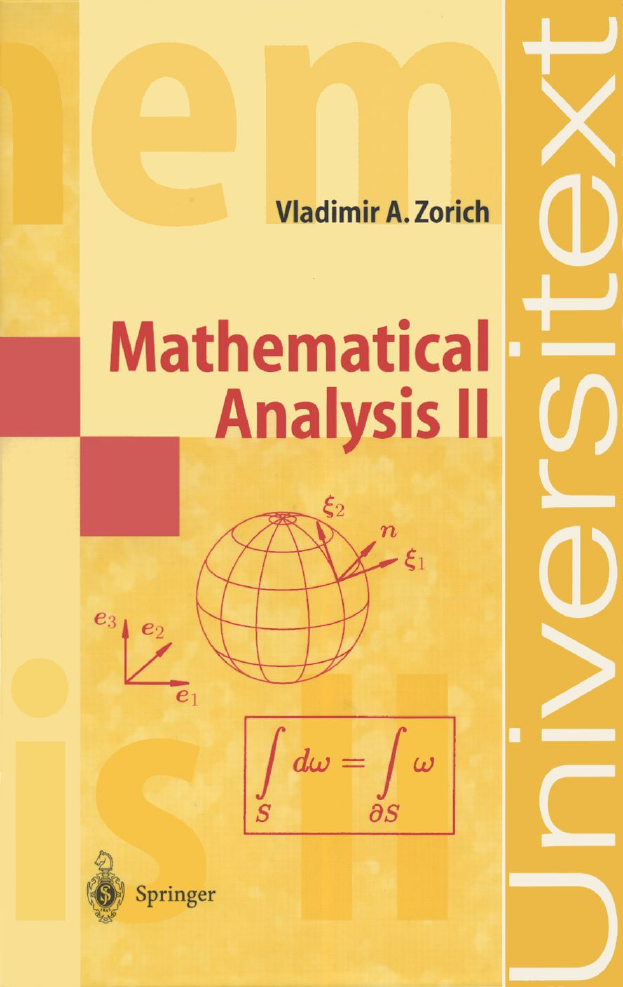

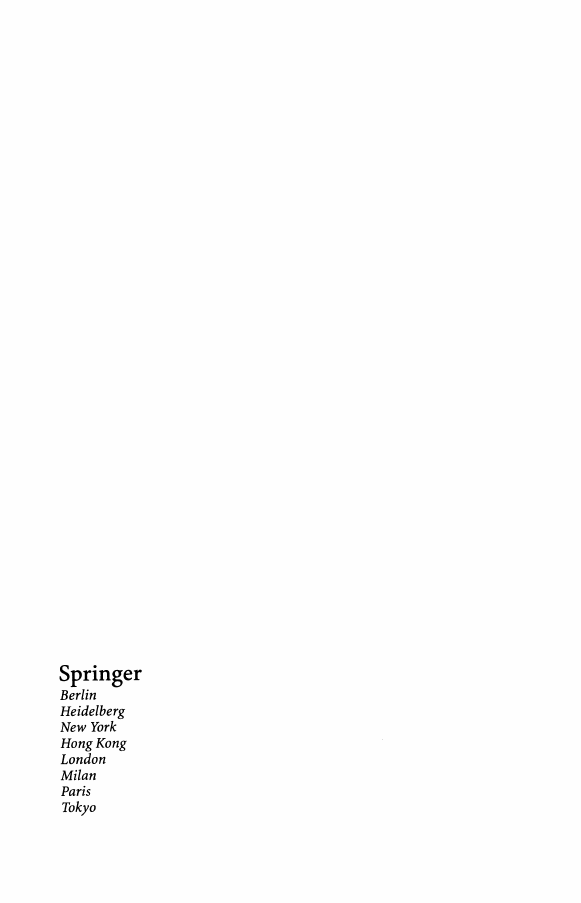
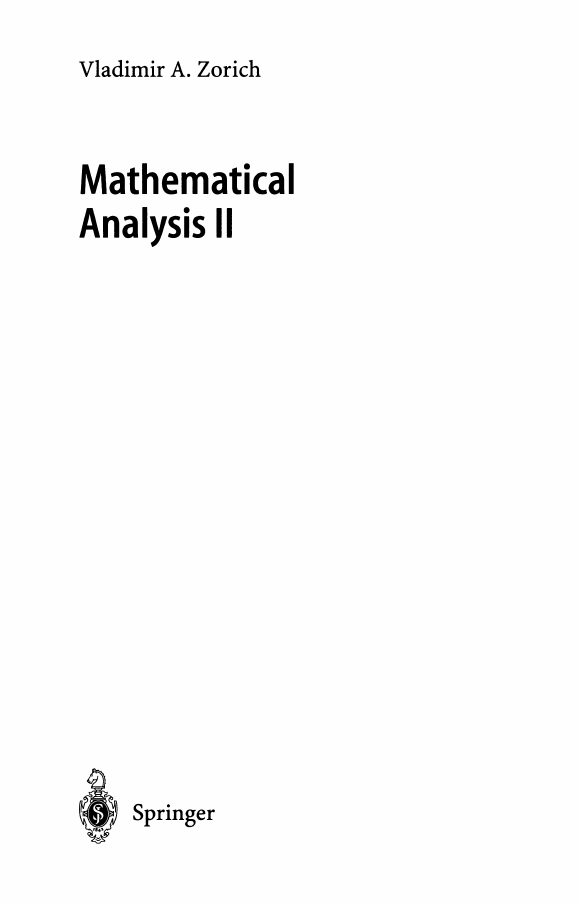
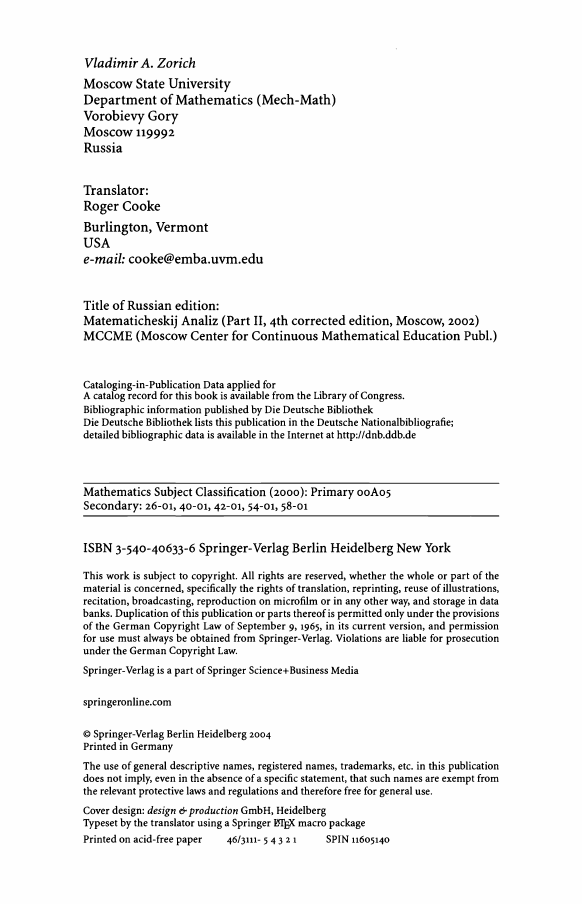


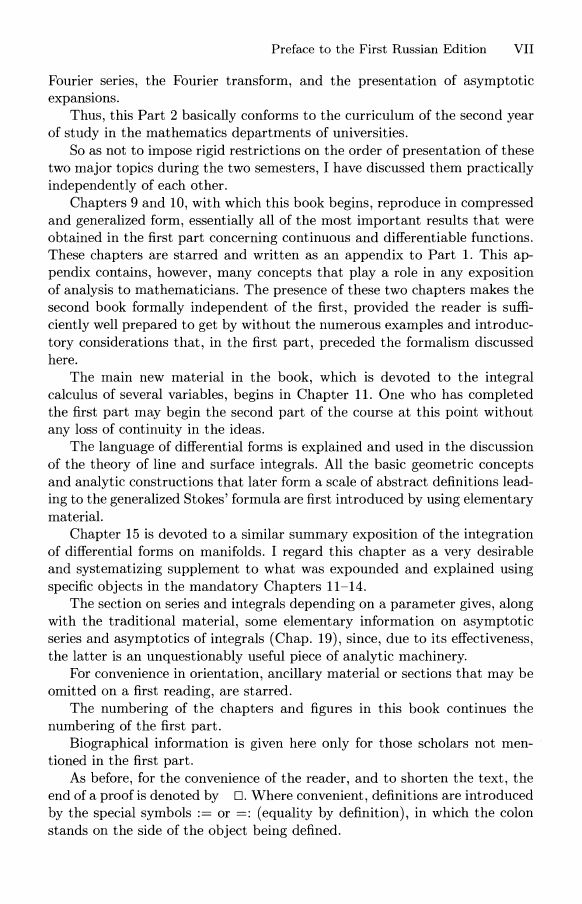








 2023年江西萍乡中考道德与法治真题及答案.doc
2023年江西萍乡中考道德与法治真题及答案.doc 2012年重庆南川中考生物真题及答案.doc
2012年重庆南川中考生物真题及答案.doc 2013年江西师范大学地理学综合及文艺理论基础考研真题.doc
2013年江西师范大学地理学综合及文艺理论基础考研真题.doc 2020年四川甘孜小升初语文真题及答案I卷.doc
2020年四川甘孜小升初语文真题及答案I卷.doc 2020年注册岩土工程师专业基础考试真题及答案.doc
2020年注册岩土工程师专业基础考试真题及答案.doc 2023-2024学年福建省厦门市九年级上学期数学月考试题及答案.doc
2023-2024学年福建省厦门市九年级上学期数学月考试题及答案.doc 2021-2022学年辽宁省沈阳市大东区九年级上学期语文期末试题及答案.doc
2021-2022学年辽宁省沈阳市大东区九年级上学期语文期末试题及答案.doc 2022-2023学年北京东城区初三第一学期物理期末试卷及答案.doc
2022-2023学年北京东城区初三第一学期物理期末试卷及答案.doc 2018上半年江西教师资格初中地理学科知识与教学能力真题及答案.doc
2018上半年江西教师资格初中地理学科知识与教学能力真题及答案.doc 2012年河北国家公务员申论考试真题及答案-省级.doc
2012年河北国家公务员申论考试真题及答案-省级.doc 2020-2021学年江苏省扬州市江都区邵樊片九年级上学期数学第一次质量检测试题及答案.doc
2020-2021学年江苏省扬州市江都区邵樊片九年级上学期数学第一次质量检测试题及答案.doc 2022下半年黑龙江教师资格证中学综合素质真题及答案.doc
2022下半年黑龙江教师资格证中学综合素质真题及答案.doc